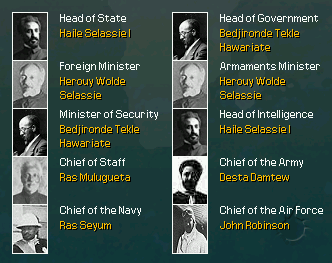Abyssinia
From Kaiserreich
| ||||

| ||||
|
| ||||
| Official Language | Amharic | |||
| Capital | Addis-Ababa | |||
| Head of State | Haile Selassie I | |||
| Head of Government | Bedjironde Tekle Hawariate | |||
| Establishment - Traditional date | circa 980 BC | |||
| Government | Autocratic monarchy | |||
| Currency | Ethiopian birr | |||
| Area | Around 1.600.000 km² | |||
| Population | About 7 millions | |||
Abyssinia, also known as Ethiopia but officially as the Ethiopian Empire is a country in Africa. Its borders are shared to the north by the Red Sea and the German colony of Somaliland, to the east by the Indian Ocean, to the south by the Freistaat Mittelafrika and to the west by Egypt-Sudan.
Along with Liberia, established during the XIXth century by freed slaves emigrated from the United States, Abyssinia was one of the only countries in Africa remaining independant during the Scramble for Africa, successfully defeating the Italian invasion in 1896. Abyssinia is also known as one of the oldest countries in the world, ruled by an Imperial dynasty claiming descent from King Solomon of Israel and the Queen of Sheba, both mentionned in the Bible. After Armenia, it is also the second-oldest country to have become officially Christian. An ally of Germany in the last stages of the Weltkrieg, Abyssinia is going under quick modernization with German support and by the will of its Emperor Haile Selassie I. However, high discontent arose from the ranks of the aristocratic landowners, and will only increase with the economic difficulties that Abyssinia is about to confront.
Contents |
History
The overthrow of Iyasu V in 1916 created more problems than it solved, as when his aunt Zauditu ascended the throne she caved in to increasing pressure from the Progressive Party to make Ras Tafari Makonnen heir to the throne - a decision that would later prove to be a serious cause of trouble. Nevertheless, Abyssinia flourished under Zauditu, culminating in the country’s 1918 entry into the Weltkrieg on the side of Germany in and the subsequent annexation of Italian Somaliland and Eritrea.Other signs of Abyssinia’s flourishing state of affairs was the expansion of the Addis Ababa-Djibouti into the Freistaat Mittelafrika in 1925, which became the Deutsche Pan-Afrikanisches EisenBahn (DPAEB). The creation of this rail link initially brought relative prosperity to eastern Abyssinia, although lately it has shown signs of economic instability.In 1930, Zauditu died, and having left no surviving children Ras Tafari Makonnen ascended to the throne as emperor Haile Selassie I without any significant problems. Upon climbing the throne the new emperor started a series of sweeping political reforms that he intended to bring Abyssinia ‘into the west’. These reforms however, were fiercely opposed by the conservative elements of the nation, who had been greatly strengthened by the annexation of the Italian colonies and the subsequent expansion of the army and navy. In 1936, Haile Selassie is facing trouble - The conservatives are growing increasingly restless over his reforms, and the DPAEB is starting to experience major economic problems. Can the Negus Negast hold on to his throne at guide Abyssinia through these troubled times to prosperity? Or will the throne fall to another?
Politics
Some political experts describe Abyssinia/Ethiopia as being "nominally a constitutional monarchy; in fact a benevolent autocracy". The Negus Negast ("King of Kings"), claiming descent from King Solomon of Israel and thus considered as the descendant of one of the oldest dynasties in the world, is the head of state and head of government, with ultimate executive, judicial and legislative power in that country. The Crown Council that has been established by the German-inspired 1931 Constitution gives only to the country an apparence of constitutional monarchy, the Council being filled by crownies and aristocrats close to the Emperor, only there to approve his reforms. Thus, the powerful opposition that arose within the country concerns both democrats who blame the reforms' hypocrisy and nobles who disapprove the country's modernization and commitment to Germany, as well as the Muslims who still suffer from the grasp of the almighty Ethiopian Orthodox Church. Succession to the throne at the death of the Monarch can be claimed by any male blood relative of the Emperor: sons, brothers, uncles or cousins: primogeniture is preferred but not always enforced.
|
Negus Negast and Responsible for Military Intelligence: His Imperial Highness Haile Selassie I (born 23 July 1892)
Prime Minister and Minister of Interior: Bedjironde Tekle Hawariate
Minister of Foreign Affairs and Finance: Herouy Wolde Selassie
Minister of War: Ras Mulugueta
Commander-in-Chief of the Ethiopian Army: Desta Damtew (born 1898)
Commander-in-Chief of the Ethiopian Navy: Ras Seyum (born 21 June 1887)
Commander-in-Chief of the Ethiopian Army Air Service: John Robinson
Military
Army
The Imperial Army was expanded after the end of the Weltkrieg, however it was still mainly composed by militias before the coronation of Haile Selassie I. When he ascended to power, he started a process of modernization of the army with the intent of bringing it up to the european standard. For this reason he created the Kebur Zabangna, the Imperial Guard based in Addis-Ababa, trained by German military advisor and supplied with modern equipment. This elite unit was organized in three battalions of trained regular infantry armed with rifles, machineguns and mortars; it also had one heavy machine-gun company. The Emperor also created his own military school at Holeta in January 1935 and invited military advisors from Germany, Flanders-Wallonia (mostly residents of the formerly Belgian Congo) and Canada (exiled British officers).
Navy and Air Force
Despite the annexation of Italian Somaliland and Eritrea and therefore of the ports of Massaua and Mogadishu, a serious military naval program was never attempted. Abyssinia has a small and recently formed airforce, composed exclusively by interceptors.
Foreign relations
Friendly relations with Germany, Freistaat Mittelafrika, Japan.
Unfriendly relations with Italian Federation, South Africa, Socialist Republic of Italy and Union of Britain


